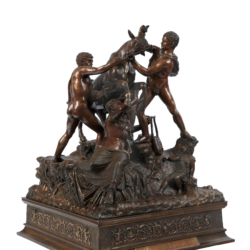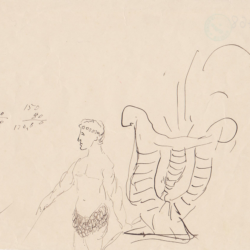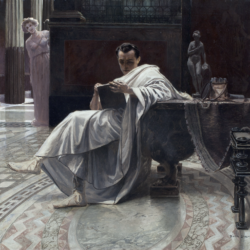
Theories and aporias
In his overview of the conceptions of heroism in the history of European culture, Ryszard Przybylski notices significant changes in relation to the antique original:
For Greeks, the highest human value was tragic heroism. The classics juxtaposed it with rational heroism. They substituted the insane metaphysical courage with the mental caution of the modern rationalists. And they transformed our only world, which for the Greeks was the battlefield of the brave man and Mysterious Destiny, or – if you wish – Inscrutable Justice, or – in other words – the Measure of All Things, into a school for meek sages, where philosophers teach the principles of conduct resulting from the Law of Nature, or – if you wish – the Eternal Reason, or – in other words – Providence.[1]
The author diachronically presents two phases of cultural transformations, extremely important for the awareness of the Europeans: on the one hand – the passage from antique tragic heroism to classical reason, and on the other hand – from reason to metaphysics and romantic madness. From the perspective of Polish literature of the second half of the 19th century, this binary opposition needs to be moderated. One of the opportunities to do so might be found in the works of Sienkiewicz – a post-romantic alumnus of Szkoła Główna[2] (The Main School, today’s University of Warsaw). Many a time, Sienkiewicz’s works proved the conventional character of later literary stratifications and openly negated the then-groundbreaking nature of Polish culture. For instance, according to the writer, the battle between new and old journalism was merely “miserable journalist guerilla warfare,” bringing the society “fatigue and the waste of strength.”[3]
Obviously, in the post-January-Rising era, the conception of heroism and the choice of the hero that would be worthy of the new rough times were important arguments in this “guerilla” discourse. Paraphrasing Tadeusz Bujnicki, we could say that Sienkiewicz pushes the boundaries[4] – in his own way – without unnecessary drama, in an unobvious and intriguing way.
“Any act of heroism is an act of charity towards the public,”[5] stated Edmund Stawiski, an economist and historian of agriculture, one generation older than Sienkiewicz, in his Księga szkiców i fragmentów (The book of sketches and fragments), published in the Biblioteka Warszawska magazine in 1867. He broadened the context of meanings understandable to the readers of the text by adding the trauma of one more rising (the manuscript[6] comes from 1856, and in 1861, the author carried the coffin of one of the participants of the brutally suppressed demonstration[7]). In this interpretation, heroism is a unique theatricalization of the lack, suffered by the public, and as such, it acquires the features characteristic of an alarming problem, calling for countermeasures. Analogously, then, “in the name of love, we need to work to eradicate poverty and to eliminate the need for charity.” Indeed, in such a perspective, heroism is not the opposite of reason:
Heroism is the highest peak of dedication and love. It is the sacrifice of everything that is dearest to a man, for the sake of belief or principle. Heroism does not measure the difficulty, does not retreat in view of the impossible; it knows no danger since heroism is a sacrifice, and it is powerful, not due to reaching the aim, but due to the power of the sacrifice. Heroism is the triumph of the spiritual greatness of a man. It is often juxtaposed with reason as two opposite poles as if reason always had to take the side of self-love, self-interest, and all small calculations of caution and the consequent predictions. It is a strange view and a strange humiliation of reason. If it did not serve to decide what is smaller and what is higher, what is worth less and what is worth more sacrifice, for what we need to sacrifice everything or nothing, it would not be a judge, but a servant to the lowest passions.[8]
These words seem to adequately reflect the post-January-Rising climate of mediation between the heart and the reason, which is also the background to Sienkiewicz’s writing. It is worth noting that it is aesthetics that is the middle ground, where all conventional oppositions disappear. Aesthetics is the area which does away with the discussed binary oppositions but does not nullify any of its parts. This is confirmed in Sienkiewicz’s (in)versions of the heroic idiom.[9].
Przypisy
- R. Przybylski, “Zmierzch rozumnego heroizmu, czyli prolegomena do romantycznego bohaterstwa” [The dawn of the rational heroism or prolegomena to romantic heroism], in Problemy polskiego romantyzmu [The problems of Polish Romanticism], series 2, edited by M. Żmigrodzka, Wrocław 1974, p. 166.
- See S. Fita, “Sienkiewicz i pokolenie Szkoły Głównej” [Sienkiewicz and the generation of Szkoła Główna], Rocznik Towarzystwa Literackiego im. Adama Mickiewicza 2006, vol. 41, pp. 47–57.
- All quotations from Sienkiewicz’s works are indicated in accordance with Dzieła [The Collected Works], edited by Julian Krzyżanowski (indicated with the volume and page number); trans. E. N. Dzieła [The Collected Works], vol. 45, pp. 269-270.
- See T. Bujnicki, “Sienkiewicz przekracza granice. O ‘przełomie’ w życiu i twórczości pisarza” [Sienkiewicz pushing the boundries: About ‘the turning point’ in the life and works of the writer], Wiek XIX. Rocznik Towarzystwa Literackiego im. Adama Mickiewicza 2009, vol. 2, no. 44, pp. 63–85.
- E. Stawiski, “Księga szkiców i fragmentów. O rozsądku” [The book of sketches and fragments: On reason], Biblioteka Warszawska 1867, vol. 3, p. 328.
- See also information on this topic in “Doniesienia literackie” [Literary news], Biblioteka Warszawska 1856, vol. 2, p. 196.
- See the painting by Aleksander Lesser Ostatnie błogosławieństwo zwłok [The last blessing of the corpse]. Information quoted after H. Rutkowski, “Edmund Stawiski,” Internetowy Polski Słownik Biograficzny [Polish Internet Bibliographic Dictionary], http://www.ipsb.nina.gov.pl/a/biografia/edmund-stawiski [date of access: 2017–01–12]
- E. Stawiski, op. cit.
- Compare with Ryszard Koziołek’s view that only literature (as opposed to journalism) enabled the writer to be for and against at the same time – See R. Koziołek, Sienkiewicz’s Bodies: Studies of Gender and Violence, trans. David Malcolm, Frankfurt am Main 2015.








